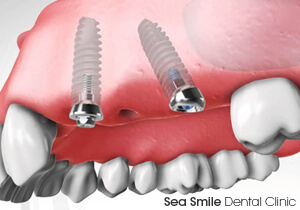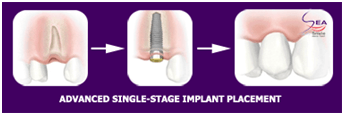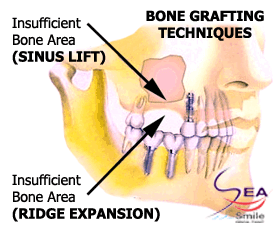Implant-Unit Placement (The Surgical Stage)

An implant-screw is a component of the Dental Implant which is embedded directly into your jawbones and eventually fuses with the bone. This implant unit is a screw-like cylinder constructed of hi-grade titanium - a highly biocompatible material, which has the ability to perform on a human body without causing any toxic or injurious response to it. Implant-screws actually replaces the tooth roots that where lost alongside with your natural tooth. They are also responsible for promoting further bone growth, specifically on the surrounding areas left by your missing tooth.
The placement of the implant unit can be referred to as the Surgical Phase of the Dental Implant Treatment. This crucial phase will be meticulously and simultaneously carried- out by your oral surgeon and prosthodontist prior to the dental crown placement, or the Prosthetic Phase of the whole Dental Implant Treament. They will carefully proceed with the procedures in conjunction with your treatment plan, as per the result of your pre-treatment evaluation and diagnostics.
The conventional 2-Stage Method is often used to conveniently place a dental implant. But with recent advances in implant dentistry, it can be already be implemented using a Single-Stage Method, in which the procedures have evolved into a simplified method for additional convenience to both the patient and dentists alike. Your oral surgeon will be able to determine what method will suit you best.
CONVENTIONAL 2-STAGE PROCEDURES

Most implant-screw surgery procedures are performed in our clinic and local anesthesia adequate enough for the entire process, but you can discuss with your oral surgion for other sedative options if you want to feel more relax during the surgery procedures. The initial step after inducing adequate anesthesia is for the surgeon to gain access to the bone in the area where the implant-screw will be placed.
This is done by scoring minor incisions in the overlying gums to expose the bone beneath. Once the bone has been exposed and sufficient bone structure has been determined, provisioning a hole will be the next step. This will be carried out simulltaneuosly with a series of drills, each with an increasing size in diameter. Once an appropriate hole size (and shape) has been attained, your surgeon will carefully insert the implant-screw into your jawbone, and subsequently repositioning the gums and sutured in place, covering the embedded implant-screw underneath your gums to properly integrate with your bone. Your dentist may provide you with tempoary dentures or crowns so that you can eat soft foods and won’t be without any teeth during the healing period. The healing period is generally within 3 to 6 months, afterwhich a minor surgery will be needed to open up the surgical site once again in order to gain access to the embedded impant-screw and be able to attach an Abutment to it. An Abutment is a component that connects and stabilzes both the implant-screw and a temporary prosthetic, in which within a few days to 2 weeks, a permanent prosthetic (dental crown, bridge, or full-denture) can finally be put in place of the temporary prosthetic.
ADVANCED SINGLE-STAGE PROCEDURES

With recent innovations in implant dentistry, a Single-Stage method of placement is now possible. This involves simplified techniques of the former conventional method and the use of modernized implant-screws (which are usually longer in length). The procedures are similar to that of the conventional 2-stage method, which is surgically placing the implant-screw onto your jawbone after being exposed by a minor incision and provitioning a hole utilizing a series of drills with increasing sizes in diameter.
The main difference is that by using a longer implant-screw, the implant head if left exposed after your gums are repositioned and sutured (stitched) in position and a healing abutment/cap can be placed over the duration of the healing period (3 to 6 months). As a result, when you go back for the Prosthetic Phase of your treatment, there is no need for additional surgical procedures to gain access to your embedded implant. Your dentist can simply remove the healing cap and replace it with the final Abutment and your final prothetic, which can either be a dental crown or bridge, even a full-denture.
Optional Procedures for Insufficient Bone Condition
One of the key factors for a successful implant placement is having sufficient amount of bone to where it is to be positioned. One instance that can to lead you to an insufficient bone quantity and quality is bone resorption; where over a period of time, after missing a tooth, the bone structure left behind starts to shrink because they are absorbed back to the body. Such a condition may complicate and increase the risk of implant placement failure, thus, additional surgical procedures may be necessary prior to the placement of a dental implant.
At Sea Smile Dental Clinic, we have the aptitude to grow bone where it’s needed, so this grants us ample opportunities to place dental implants of proper length and width. A bone-grafting (bone-adding) procedure may include any of the following:
- Bone Augmentation — is typically used in a situation when there is insufficient amount of bone to place an implant, most commonly because the tooth has been missing for quite some time. This procedure generally involves a surgical incision to open your gums to be able to insert additional bone to the area. The additional bone used may come from various grafting techniques like autogenous (from your own body), allogenic (from a cadaver), or xenograft (commercial bone). Your oral surgeon may include a membrane over the added bone before closing the incision with stitches, to balance the bone growth over your gum line during healing, which usually takes about 6 to 9 months before an implant can be placed. This procedure usually takes place under IV (intravenous) sedation in a surgeon’s clinic.
- Sinus Lift Procedure — also known as a Sinus Augmentation, the procedure is suggested when your upper jaw becomes unaccommodating for an implant placement due to insufficient bone height, or your sinuses have close proximity to your jaws. The procedure elevates or “lifts” the sinus membrane and additional bone is placed in the space between your jaw and the lifted membrane.
- Ridge Expansion — is mostly used for severe cases of bone resorption or when your jaw is not wide enough to receive dental implants. The procedure literally expands the bony ridge (top) of your jaw by splitting it using a special saw and packing in additional bone on the created space. This procedure is also known as a split-ridge technique, and is possible to be carried out under local anaesthesia.

Post-Operative Care (After Implant Surgery)
It is vital that proper instructions given by your dentist or oral surgeon be strictly observed, especially after the surgical procedure wherein the titanium implant screws are secured inside your gums. This may as well lead to a faster bone-integration and more stable foundation for your final prosthesis or dental crown, henceforth, resulting in a very successful post-operative recovery.
- Strictly follow your dentist’s prescribed medications like Antibiotics and Pain Relievers.
- Carefully apply gentle pressure to stop any bleeding by placing the provided gauze directly over the surgical site. If excessive bleeding persists, immediately contact our clinic.
- If any swelling occurs, simply place colds packs on the swelled area. (20 minutes on, and then 20 minutes off, repeating the interval if necessary, especially during the first 6 to 8 hours)
- Eat only soft foods for next few days after your surgery. Avoid anything grainy like nuts or popcorn and don’t try to chew hard or crunchy foods, as this might cause additional invasiveness and these foods can leave certain particles on the implant site.
- Do not smoke tobacco, especially right after the surgery. Nicotine or tar can be harmful on the surgical site, and inhaling could loosen the blood clot which could lead to excessive bleeding and cause more problems.
- Do not consume any alcohol during the day of your surgical procedure and while on antibiotic and pain medications.
Advanced Implant Placement Technology
With a rapid development in the field of implant dentistry, we at Sea Smile Dental Clinic never cease to cope up with the situation. Our team of prosthodontists and oral surgeons managed to stay on the forefront of such advancement, thus we are truly proud to be able to offer the latest in dental implant technology.
IMMEDIATE IMPLANT PLACEMENT AFTER TOOTH EXTRACTION
Our clinic is constantly embracing the modern techniques of implant dentistry, enabling us the ability to immediately place implants at the same time that your tooth is extracted. This further reduces the number of surgical procedures in contrast with the traditional process of having to wait for a period of three or more months, the required period of time for your bone to obtain proper healing before an implant can be placed. With special techniques and modern equipment, our dentists and oral surgeons can expertly place the implant unit during your same tooth extraction appointment, thereby eliminating the inconvenience of the traditional three month waiting period.
IMMEDIATE-LOADING DENTAL IMPLANTS
Advances in implant structure and modern techniques were able to reduce treatment time without compromising the aesthetic and functional results, thus the emergence of Immediate-Loading Dental Implant Treatment. Decreasing the length of dental implant procedures and eliminating the need for removable units, Immediate-loading Implants also helps in maintaining both your soft and hard tissue levels, which significantly provides enhanced aesthetics in general.
COMPUTER-GUIDED IMPLANT PLACEMENT
With our full effort to provide convenience to our patients and constantly adapt to the latest technological advancement in dentistry, Sea Smile Dental Clinic also offers Computer-Guided Dental Implant Treatments. We have arrogated the NOBELGUIDE® System to provide you with this state-of-the-art computer-guided planning and implant placement. Right from the very start of your treatment, the system will be utilized in your evaluation and treatment planning, your guided-surgical drilling and implant unit placement, to that perfectly great and immediate smile ahead of you.

